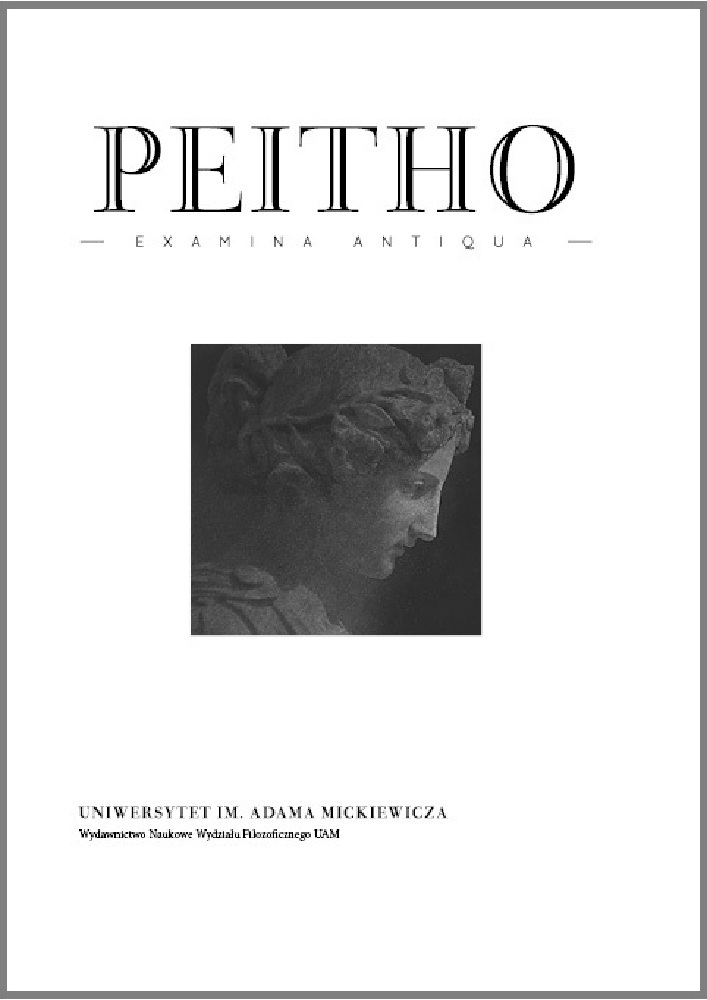Abstract
This paper shows the role of ὀνοματοποιεῖν in Neoplatonism and how this practice is ruled by an onto-logical canon. While ὀνοματοποιεῖν itself means the making of a brand new name, its usage is manifold. As Aristotle explains in Rh. III 2, poets take advantage of ὀνοματοποιεῖν to catch the undefined and give it a recognisable image, by means of a metaphorical name. In science, this practice, codified by Aristotle, is twofold: ὀνοματοποιεῖν meant both to re-semanticize words wellknown and to create names ex novo for things not discovered or studied yet. After analysing ὀνοματοποιεῖν’s recurrence in Aristotle, I illustrate that, according to Neoplatonic Commentators, impositio can be, both natural and technical, only of things in actuality, having a solid consistency. Intermediates between contraries, presumed relatives and powers as qualities are nameless – as Philoponus notices in his In Categorias – since they haven’t an independent status and aren’t definable. This bond between the original rhetorical practice and the ontological perspective, sketched in Int. 1, was strengthened by Alexander, who filled Aristotle’s gaps, stating that names signify things’ being, i.e. the form acquired in actuality.
References
Ackrill, J.L. (transl. & notes), 2002, Aristotle’s Categories and De Interpretatione, Oxford, [I ed. 1963].
Bodéüs, R., 1984, “Aux origines de la doctrine aristotélicienne des Catégories,” Revue de philosophie ancienne 2 [1], pp. 121–137.
Bodéüs, R. (text. & trad.), 2001, Aristote. Catégories, Paris.
Bolton, R., 1985, “Aristotle on the Signification of Names,” in: Language and Reality in Greek Philosophy. Papers read at the second international philosophy symposium, May 1984, Athens, pp. 153–162.
Bolton, R., 1993, “Division, définition et essence dans la science aristotélicienne,” Revue philosophique de la France et de l’Étranger 118 [2], pp. 197–222.
Calboli Montefusco, L., 2004, “Le fondement logique de la métaphore selon Aristote,” in: M.S. Celentano, P. Chiron, M.P. Noël (éd.), Skhèma/Figura: formes et figures chez les Anciens: rhétorique, philosophie, littérature, Paris, pp. 115–126.
Charles, D., 2010, “Definition and explanation in the Posterior analytics and Metaphysics,” in: D. Charles (ed.), Definition in Greek Philosophy, Oxford–New York, pp. 286–328.
Corcilius, K., 2007, „Wann ist eine Übersetzung besser als die andere?,“ in: H. Böhme, Ch. Rapp, W. Rösler, (Hrsg.), Übersetzung und Transformation, Berlin–New York, pp. 173–189.
Dalimier, C., 2004, “L’usage scientifique de la métaphore chez Aristote,” in: M.S. Celentano, P. Chiron, M.P. Noël (éd.), Skhèma/Figura: formes et figures chez les Anciens: rhétorique, philosophie, littérature, Paris, pp. 127–141.
Ferejohn, M.T., 1994, “Matter, Definition, and Generation in Aristotle’s Metaphysics,” Proceedings of the Boston Area Colloquium in Ancient Philosophy 10, pp. 35–58.
Georgiadis, C., 1985, “Aristotle’s Treatment of the Anonyma,” in: Language and Reality in Greek Philosophy. Papers read at the second international philosophy symposium, May 1984, Athens, pp. 204–209.
Giardina, G.R., 2012, Fisica del movimento e teoria dell’infinito: analisi critica di Aristotele, Phys. III, Sankt Augustin.
Gilardoni, S., (1999), “La teoria dell’impositio e la nozione di causa inventionis. L’origine del linguaggio nella riflessione tardo-antica e medioevale,” in: C. Milani (ed.), Origini del linguaggio, Verona, pp. 127–134.
Gottlieb, P., 1994, “Aristotle’s ‘Nameless’ Virtues,” Apeiron 27 [1], pp. 1–15.
Louis, P., 1971, “Animaux anonymes chez Aristote,” Bulletin de l’Association Guillaume Budé 1 [2], pp. 211–217.
Mignucci, M., 1986, “Aristotle’s Definitions of Relatives in Cat. 7,” Phronesis 31 [2], pp. 101–127.
Noriega-Olmos, S., 2013, Aristotle’s Psychology of Signification: A Commentary on “De Interpretatione” 16 a 13–18, Berlin–Boston.
Rhys Roberts, W., 2004, Aristotle’s Rhetoric, New York (unabridged republication of the Rhetoric published in London in 1924, under the editorship of D. Ross).
Salzmann, Z., Stanlaw, J., Adachi, N., 2015, Language, Culture, and Society: an Introduction to Linguistic Anthropology, Boulder, CO.
Walz, M.D., 2006, “The Opening of On Interpretation: Toward a More Literal Reading,” Phronesis 51 [3], pp. 230–251.
Zucca, D., 2011, “Cat. 7, 7b15–8b24 – Lo status aporetico dei relativi,” in: M. Bonelli, F. Guadalupe Masi (cur.), Studi sulle Categorie di Aristotele, Amsterdam, pp. 191–212.
License
Peitho provides immediate open access to its content on the principle that making research freely available to the public supports a greater global exchange of knowledge.
